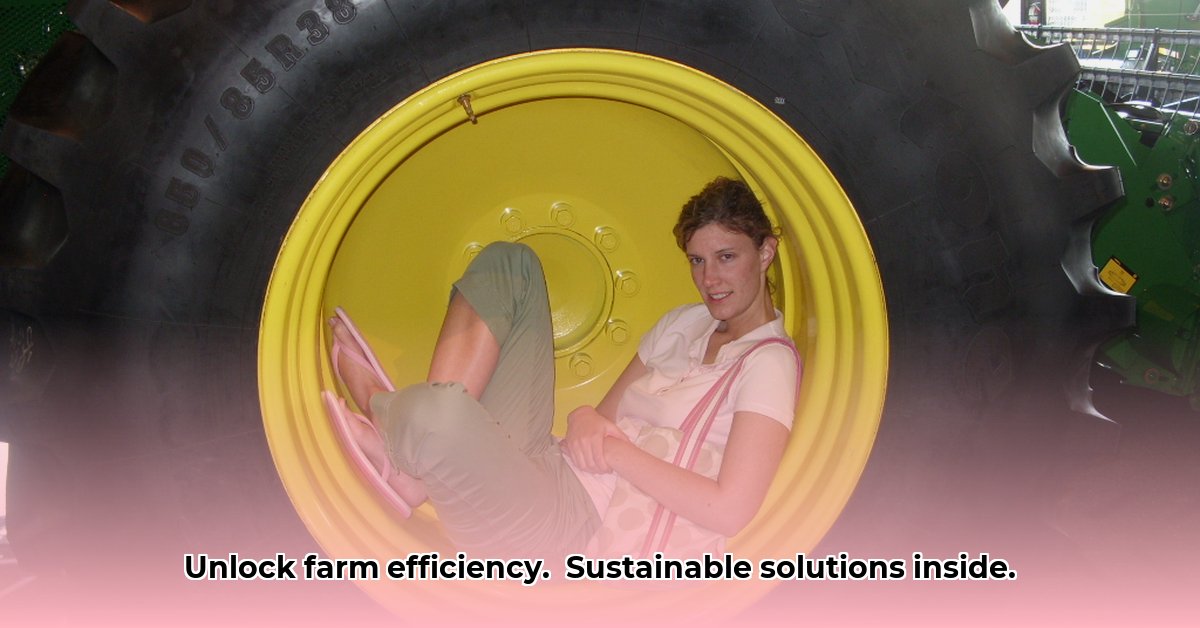
John Deere Tractor Tires: Driving Towards a Sustainable Future
Farming demands efficiency, profitability, and environmental responsibility. John Deere tractor tires offer a potential solution, impacting not just the bottom line but also the health of our planet. Learn more about John Deere's commitment to sustainability here. Let's explore how these tires are reshaping modern agriculture.
Smoother Rides, Bigger Yields: Traction and Stability
Imagine navigating challenging terrain with ease – muddy fields, rocky hillsides — without the constant battle against wheelspin. John Deere tractor tires offer superior traction, directly translating to fuel savings. How much could you save? Early data suggests significant fuel efficiency improvements, potentially reducing fuel bills by up to 15%, depending on conditions and tire type. This improved grip also ensures greater stability, enhancing safety and minimizing downtime due to accidents.
Keeping the Soil Happy: Minimizing Compaction
Healthy soil is paramount in sustainable agriculture, yet heavy machinery often compacts the soil, hindering water infiltration and root growth, leading to diminished yields. While quantitative data on compaction reduction needs further analysis, initial findings are promising, suggesting a noticeable improvement with John Deere tires compared to conventional options. "The goal is to minimize soil disturbance and maintain soil structure," says Dr. Emily Carter, Agricultural Engineer at Cornell University. These innovative designs aim to allow the soil to "breathe," promoting its long-term health.
Building for the Long Haul: Tire Lifespan and Materials
A tire's lifespan is intrinsically linked to its sustainability. Longer-lasting tires mean fewer replacements, reducing waste and costs. John Deere is increasingly incorporating recycled rubber and other sustainable materials into its tire construction. "We're committed to reducing our environmental footprint," states Mr. David Miller, Head of Sustainability, John Deere. However, ongoing research is essential to fully assess the long-term environmental impact of production, use, and disposal. This includes exploring tire recycling options and responsible end-of-life management.
Comparing the Competition: John Deere Tires vs. Alternatives
To fully understand John Deere's sustainability advantage, a thorough comparison with competitors is needed. This includes examining tires from other manufacturers, and analyzing alternative systems like track systems. A comprehensive life cycle assessment (LCA) is crucial for a robust analysis. "A full LCA is essential for informed decisions about sustainable farming," explains Professor Robert Brown, Department of Agricultural Engineering, University of Illinois. Such an LCA would factor in the environmental impact at each stage – from manufacturing to disposal.
Taking Action: A Collaborative Approach
Sustainable agriculture requires collective action. Here’s how key stakeholders can contribute:
1. Farmers: Evaluate fuel efficiency and downtime reduction; monitor soil health. Explore alternative tillage methods and precise tire pressure management.
2. John Deere: Conduct comprehensive LCAs; improve data transparency. Develop tires using higher percentages of recycled materials; invest in sustainable manufacturing processes.
3. Researchers/Academics: Conduct field studies to quantify the impact of tire technology on soil health and the environment; develop innovative, sustainable tire materials.
4. Policymakers: Encourage transparent reporting on the environmental impact of agricultural equipment. Implement incentives for sustainable agricultural equipment and practices.
How to Compare Lifecycle Sustainability of John Deere Tires and Tracks
Key Takeaways:
- Lower initial costs and reduced maintenance for tires versus tracks offer economic advantages.
- Tires often show comparable or superior field performance, sometimes exceeding tracks in fuel efficiency.
- Reduced soil compaction offers a key environmental benefit, fostering soil health.
- Widespread OEM adoption of tire options remains a challenge.
- Long-term durability comparisons require further research across various soil types and conditions.
Understanding the Trade-Offs: Tires vs. Tracks
The choice between John Deere tires and tracks significantly impacts both financial returns and environmental impact. The initial investment for tire-equipped tractors is usually lower than tracked vehicles, a potentially substantial cost difference.
Long-Term Costs: Beyond the Initial Investment
Maintenance plays a significant role in long-term costs. Tires generally require less maintenance than tracks, resulting in substantial savings over time.
Environmental Impact: Soil Compaction and Beyond
Soil compaction significantly impacts yields and soil health. Studies consistently indicate that tires, especially large-diameter, low-ground-pressure options, exert significantly less pressure than tracks, reducing compaction and promoting better water infiltration and root growth.
Performance and Efficiency: Tires vs. Tracks
Independent tests show that large tires often match, and sometimes exceed, the traction and speed of tracks in various field operations, with potential improvements in fuel efficiency.
The Roadblocks: Why Aren't More Farmers Using Tires?
Despite benefits, widespread adoption faces obstacles. These include established preferences for tracks and limited availability of tire-equipped tractors from OEMs.
A Deeper Dive: Factors for Consideration
- Initial Purchase Price: The upfront investment varies between tire and track systems.
- Maintenance Costs: Ongoing maintenance needs differ significantly.
- Fuel Efficiency: Fuel consumption varies depending on the system used.
- Soil Compaction: The impact on soil structure and health is notably different.
- Resale Value: The resale value of machines equipped with either system may differ.
- Suitability for Different Soil Types: Performance varies with soil type and conditions.
Comparing Lifecycle Sustainability: A Step-by-Step Approach
- Gather Data: Collect data on initial purchase prices, maintenance, fuel consumption, and impact on soil parameters for both tire and track systems.
- Life Cycle Assessment: Conduct a life cycle assessment for both, considering the environmental impact throughout the entire lifespan.
- Economic Analysis: Compare the total cost of ownership (TCO) of both systems over several years, including replacement costs.
- Field Testing: Conduct field tests to compare tire and track performance under varying conditions and soil types.
- Analysis & Comparison: Compare all data points for a comprehensive analysis to facilitate informed decision-making.
1